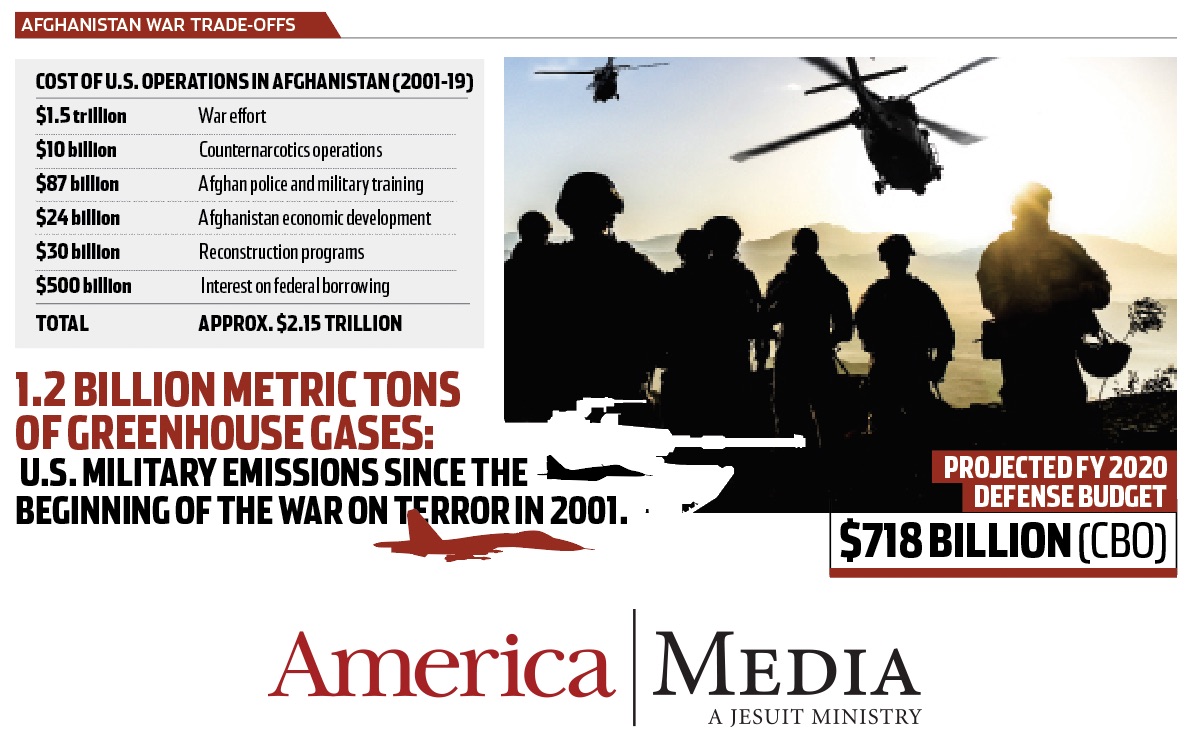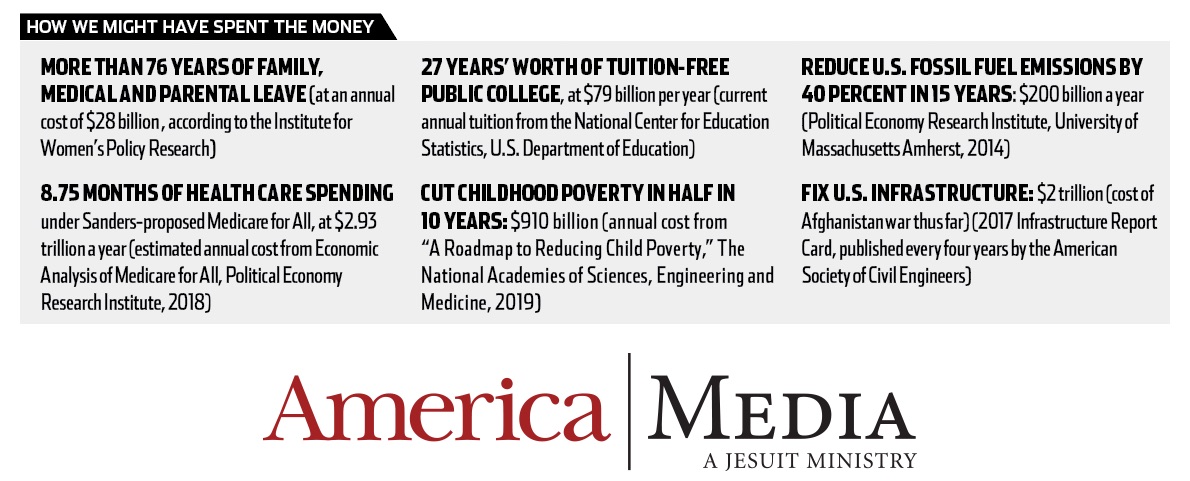How close were the United States and Iran to another Middle East war in January? The prospect of a new conflict, and its cost in blood and treasure, was surely on the minds of many Americans—75 percent of whom say that the United States’ disagreements with Iran are not serious enough to warrant another war—especially those who read a sobering report from The Washington Post published just a few weeks before the United States and Iran traded air strikes over Iraq. “The Afghanistan Papers: A Secret History of the War” described in detail the results of an internal review of the failures and miscalculations of this previous—and ongoing—military misadventure in the region.
“These papers basically confirm the concerns that many just war ethicists back in 2001 raised,” said Tobias Winright, a theological ethicist at Saint Louis University in Missouri. He remembers many who challenged the idea that a large-scale military intervention was the most appropriate moral and practical response to the terrorist attacks of 9/11. Many urged instead a measured “police, SWAT-like response,” he recalled.
Now “here we are, all these years later”—still in Afghanistan. “One of the core criteria I and others have argued for from the just war tradition is right intent: If you are going to use the military, is it really to establish a just peace…a positive peace?” Not only has the U.S. intervention failed to achieve that objective, he pointed out, it has not even been able to achieve “a negative peace”— that is, the mere absence of violence.
If there is a lasting lesson to emerge from the experience of the United States in Afghanistan, it could be one shared by Ms. Cusimano Love: “It’s much easier to start a war than it is to finish it,” she said.
Trying to make sense of that outcome, more than 400 military and civilian officials were interviewed by the Office of the Special Inspector for Afghanistan Reconstruction as part of its Lessons Learned program. Meant to diagnose policy failures in Afghanistan, the program was hidden from public view until The Post won the release of its findings after a three-year court battle.

The Afghanistan papers offer a litany of intelligence errors, strategic blunders and expressions of sustained, widespread uncertainty regarding the U.S. mission in Afghanistan. During his interview for Lessons Learned, former Afghan war czar Lt. Gen. Douglas Lute said in 2015, “We were devoid of a fundamental understanding of Afghanistan—we didn’t know what we were doing”—a fitting summary of the sentiment expressed by scores of other combat officers, diplomats and Pentagon strategists who participated in the policy postmortem. According to The Post, those documents reveal “there was no consensus on the war’s objectives, let alone how to end the conflict.”
The same day The Post released its grim exposé, The New York Times published a summary of a report from Brown University’s Cost of War project. According to those researchers, the United States has spent $2.15 trillion so far in efforts to contain the Taliban, Al Qaeda and now ISIS militants and to stabilize Afghanistan’s government and civil society.
During that time, the war has cost the lives of 2,351 American military personnel and an estimated 43,000 Afghan civilians. Yet more than 18 years after U.S. and NATO troops first arrived to begin the longest war in U.S. history, the stable, democratic Afghanistan the United States struggled to establish remains acutely vulnerable to collapse, and an emboldened and patient Taliban appears content to simply wait out the Americans.
The war has cost the lives of 2,351 American military personnel and an estimated 43,000 Afghan civilians. Yet the stable, democratic Afghanistan the United States struggled to establish remains acutely vulnerable to collapse.
Karen J. Greenberg, director of the Center on National Security at Fordham University School of Law, said that there were many unknowns when the United States first went to war in Afghanistan. “Among them was how exactly this tribal country functions, what role the warlords and others were playing vis-a-vis the United States and other countries. In other words, who to trust, what their actual goals were, how they viewed the Americans.”
A persisting “known unknown,” to borrow former Secretary of Defense Donald Rumsfeld’s memorable phrase, is what might happen in the aftermath of a U.S. military withdrawal. “Will Al Qaeda reestablish itself?” Ms. Greenburg asked. “Will other Islamist terrorist groups take root?” Perhaps most poignantly after so many years and so much sacrifice: What will happen to the political, civil and military leaders who had aligned themselves with the United States when they are left behind? Mr. Winright fears one increasingly likely outcome: a Saigon-style collapse in Kabul and other cities where U.S. allies have managed precarious redoubts against the Taliban.

The unhappy revelations turned up by the Afghanistan papers did not come as much of a surprise to Maryann Cusimano Love, a professor of International Relations at the Catholic University of America in Washington, D.C. She has attended enough briefings and read enough situation reports emerging from the conflict over the years to have long ago concluded it has been a debacle. “It was not a pretty picture ever,” she said, describing Afghanistan as a “horror story of lost money, lost tax dollars, lost lives and not a whole lot to show for it in return.”
If there is a lasting lesson to emerge from the experience of the United States in Afghanistan, it could be one shared by Ms. Cusimano Love: “It’s much easier to start a war than it is to finish it,” she said. “It’s much easier to get in than it is to achieve objectives by force.”
All the hard-earned wisdom and expertise within the U.S. military could not overcome the political momentum for war in the aftermath of the terror strikes at home.
She remembered that in the first week after the 9/11 attacks, Colin Powell, then secretary of state, laid out the reasons why resorting to war in Afghanistan was probably not the best option, “and he laid out all the nonmilitary means to try to fight terror.” In confronting terrorism, she said, “before entering Afghanistan, we had a lot of data about what works and what doesn’t,” an understanding of the difficulty of defeating rural insurgencies, and a palette of nonmilitary options to achieve diplomatic and political aims.
At the time, Ms. Cusimano Love was teaching a class that included military officers who were charged with conducting the war. They would often talk, she recalled, about how hard it was to identify military objectives in Afghanistan aside from “rearranging the rubble” left behind by years of conflict the country had already endured driving out the Soviet Union and then during a prolonged civil conflict.
“That’s what Afghanistan was like going in,” Ms. Cusimano Love said. “You knew that insurgencies would last a very long time, that the central government would have a difficult time asserting control and that [the military option] would not be the best use of force.”
But all the hard-earned wisdom and expertise within the U.S. military could not overcome the political momentum for war in the aftermath of the terror strikes at home. Under the Constitution, civilian decision-makers have the final say about how the military is used, no matter what lessons military planners have taken to heart. The military can advise and counsel, but the politicians “set the tone.”
“Military force is limited in what it can achieve and sometimes the other tools in the toolbox,” like peace building, “are more effective—but they oftentimes are less politically attractive.”
“So we kind of learn these lessons over and over again,” Ms. Cusimano Love said, “that military force is limited in what it can achieve and that sometimes the other tools in the toolbox,” like peace building, “are more effective—but they oftentimes are less [politically] attractive.
“They also don’t have big price tags associated with them,” she said. “You don’t need big equipment or aircraft carriers and nuclear missiles to do peace-building, so you don’t have defense contractors lobbying for those particular avenues of policy.
“It’s a structural problem. It’s not just on particular personalities, that sometimes the more effective things to do are harder to get through the political gauntlet.”
Reading through the Afghanistan papers, David Cortright, director of policy studies at the University of Notre Dame’s Kroc Institute for International Peace Studies, drew some overriding lessons. “One is that the top senior people in the military knew that the war was unwinnable. There was no way that we were going to defeat the Taliban, and they’ve known that for years.”
Yet U.S. military soldiered on in Afghanistan, proposing troop surges, promising successes. “They deceived the public,” Mr. Cortright said.
“And politicians, who received enough accurate information to know better, continued the war out of what I would consider political cowardice,” he said. No one wanted to be the leader who told the U.S. public the truth about Afghanistan, that the war against the Taliban was unwinnable “and probably unjust and that we should have never gone in.”
“It reminds me so much of Vietnam, where you had [Secretary of Defense Robert] McNamara and others who knew in 1967, ’68, certainly after Tet in 1968, that there was no way we were going to win this war, but they kept on, increased the bombing.”
And in that unwillingness to accept the truth and share the bad news lies another lesson, he said. In Afghanistan, as in Vietnam, when all else fails, U.S. strategists seem to fall back on escalating aerial campaigns under the mistaken belief that “even if we can’t win with the troops on the ground, we can bomb them sufficiently to force the other side to cave in or capitulate to our demands.”
Mr. Cortright believes that Iran likewise will not be brought to accept America’s will through the force of drones or missiles or a bombing campaign. The Islamic Republic of Iran has already demonstrated its mettle, enduring nearly a decade of war with Iraq, he pointed out, suggesting that the U.S. public, with the Afghanistan deceptions in mind, should be skeptical of the aggressive rhetoric against Iran emanating from the current occupants of the White House.
“The reality is that there’s no way we can achieve any policy goals with Iran through these military means,” Mr. Cortright said, noting in frustration “just an unwillingness to even consider the fact that maybe we can negotiate [with Iran], maybe we can work out a better deal and to accept that we had a pretty good deal with the Iran nuclear agreement.”
Afghanistan “has been a quagmire, and that’s a lesson learned,” Mr. Winright said. “In the future we need to take seriously [just war] considerations.” He worries that President Trump does not know about just war standards or “care about them” if he does.
“Iran could be much worse, if it escalates, than either Afghanistan or Iraq,” Mr. Winright said. “This kind of impulsive recklessness is very dangerous. I’m very concerned.”
“I think [the Afghanistan experience] shows that just war tells you how to limit war. It doesn’t tell you what’s necessary to build peace,” said Ms. Cusimano Love. “So even if you could have made a just war argument for the invasion of Afghanistan, it still wouldn’t lead up to how to build a positive peace.”
With reporting from Ryan Di Corpo, Joseph A. O’Hare fellow.









